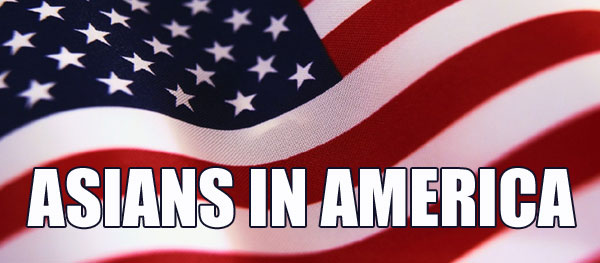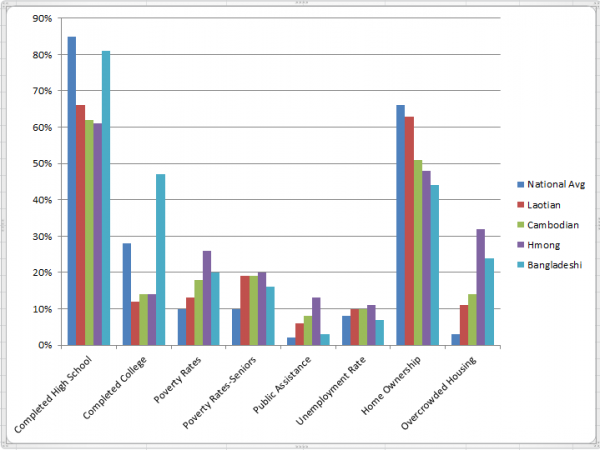
Recently, I covered the some of the overview of the numbers and statistics as they relate to Asian Americans in a new report from the Asian American Center for Advancing Justice (Advancing Justice). As I mentioned in the previous article, never before have we gotten such detailed information on each of the different Asian sub-groups. I’ve already covered the Taiwanese sub-group in detail; in this post, I’m going to focus on the sub-groups that tend to be under-represented, and whose numbers lie outside the norm.
Let’s start with one of the biggest myths around Asian Americans, and that’s with educational attainment and Asian Americans doing well in school. While that’s true for some sub-groups, the Hmong, Laotian and Cambodian communities have significant disparity here. Compared with the national rate of 85% of the population having completed high school, only 66% of Laotian Americans, 62% of Cambodian Americans, and 61% of Hmong Americans have done so. The numbers are just as bad if not worse for completing college. For the general population, the rate is 28% compared to 12% for Laotian Americans and 14% for both Cambodian and Hmong Americans.
The next myth to break is around income. While some Asian American sub-groups have higher per-capita income than the national average, once again, certain sub-groups are significantly lower than the national average. These four Asian sub-groups are not only below the national average, but also below African Americans. Hmong Americans have the lowest per-capita income of any racial sub-group, lower than that of Latinos at $10,949, compared with the national average of $27,100. Cambodian Americans come in at $15,940, Laotian Americans at $16,585, and Bangladeshi Americans at $16,784. There are other Asian sub-groups that come in below the national average, although not quite as significantly, and they include Vietnamese Americans at $21,542, Thai Americans at $21,708, Pakistani Americans at $24,663, Indonesian Americans at $25,729, Filipino Americans at $25,799, and Korean Americans at $26,118.
Perhaps, what should not be surprising after seeing the per-capita numbers, are the poverty rates. Hmong Americans, the worst off, have a shocking 26% poverty rate. Bangladeshi Americans come in at 20%, Cambodian Americans at 18%, and Pakistani Americans at 15%, Vietnamese and Thai Americans come in at 14%, and Laotian and Korean Americans at 13%. The national average is 10% living below the poverty line.
If you look specifically at the poverty rates of seniors, the numbers remain pretty bad. Korean Americans lead here, with 21% of their seniors in poverty. Hmong Americans come in at 20%, Laotian and Cambodian Americans at 19%, and Chinese (except Taiwanese) at 17%. The general senior population rate of poverty in the U.S. is 10%.
With poverty comes the need for public assistance. The national rate of those accessing public assistance comes in at 2%. For Hmong Americans the rate is 13%, Cambodian Americans 8%, and Laotian Americans at 6%.
Unemployment rates are also the highest for Hmong Americans at 11%. Laotian and Cambodian Americans come in at 10% with the national rate at the time of measurement coming in at 8%.
The reasons for such a disparity in the Hmong, Cambodian and Bangladeshi communities, when compared with other Asian communities may have to do with the industries in which these communities work. These groups are much more likely (sometimes as much as 3 times as likely) to work in construction, transportation, manufacturing or service jobs, compared with higher income groups which have jobs focused in managerial, professional, sales and office.
Next if you look at housing, these numbers align with the education, income and poverty numbers as well. Bangladeshi, Hmong, Korean, and Cambodian Americans have the lowest levels of home ownership, with 44%, 48%, 49% and 51% as homeowners respectively, compared with 66% nationwide. Along with levels of home ownership is levels of overcrowding in housing. Hmong Americans have it worst here, with 32% living in overcrowded conditions, followed by Bangladeshi Americans at 24%. Pakistani and Cambodian Americans come next at 14%, and then Laotian Americans at 11%, compared with the national average of 3%.
The last segment looked at was health insurance. And not surprisingly, Pakistani, Bangladeshi, Korean, Cambodian, Vietnamese, Thai, Laotian and Hmong Americans rank among those Americans who are more likely to be uninsured than the general population.
These numbers show that there’s a significant portion of the Asian American community that doesn’t follow the stereotype, and are significantly under-represented and under-served in our community. In addition to having the lowest income, being the least educated, and highest unemployment, these Asian Americans are also least likely to seek out public assistance, as the numbers show much fewer of these Asian Americans taking advantage of government programs than want the numbers show for negatively affected populations. As the report recommends, there needs to be much more outreach to these affected communities to make them aware of and help them access programs that may be of help to them. And that’s probably just the tip of the iceberg.
- Excited
- Fascinated
- Amused
- Disgusted
- Sad
- Angry










